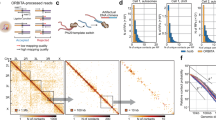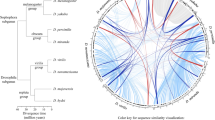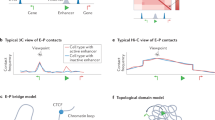Abstract
Comparative genomics of nucleosome positions provides a powerful means for understanding how the organization of chromatin and the transcription machinery co-evolve. Here we produce a high-resolution reference map of H2A.Z and bulk nucleosome locations across the genome of the fly Drosophila melanogaster and compare it to that from the yeast Saccharomyces cerevisiae. Like Saccharomyces, Drosophila nucleosomes are organized around active transcription start sites in a canonical -1, nucleosome-free region, +1 arrangement. However, Drosophila does not incorporate H2A.Z into the -1 nucleosome and does not bury its transcriptional start site in the +1 nucleosome. At thousands of genes, RNA polymerase II engages the +1 nucleosome and pauses. How the transcription initiation machinery contends with the +1 nucleosome seems to be fundamentally different across major eukaryotic lines.
This is a preview of subscription content, access via your institution
Access options
Subscribe to this journal
Receive 51 print issues and online access
$199.00 per year
only $3.90 per issue
Buy this article
- Purchase on Springer Link
- Instant access to full article PDF
Prices may be subject to local taxes which are calculated during checkout





Similar content being viewed by others
Accession codes
Primary accessions
ArrayExpress
Data deposits
Sequence data are deposited in the NCBI Trace Archives TI SRA000283 under the Sequencing Center designation ‘CCGB’, and microarray data are deposited in the ArrayExpress under accession numbers E-MEXP-1515, E-MEXP-1519 and E-MEXP-1520.
References
Albert, I. et al. Translational and rotational settings of H2A.Z nucleosomes across the Saccharomyces cerevisiae genome. Nature 446, 572–576 (2007)
Barski, A. et al. High-resolution profiling of histone methylations in the human genome. Cell 129, 823–837 (2007)
Guenther, M. G., Levine, S. S., Boyer, L. A., Jaenisch, R. & Young, R. A. A chromatin landmark and transcription initiation at most promoters in human cells. Cell 130, 77–88 (2007)
Lee, W. et al. A high-resolution atlas of nucleosome occupancy in yeast. Nature Genet. 39, 1235–1244 (2007)
Mito, Y., Henikoff, J. G. & Henikoff, S. Genome-scale profiling of histone H3.3 replacement patterns. Nature Genet. 37, 1090–1097 (2005)
Pokholok, D. K. et al. Genome-wide map of nucleosome acetylation and methylation in yeast. Cell 122, 517–527 (2005)
Yuan, G. C. et al. Genome-scale identification of nucleosome positions in S. cerevisiae. Science 309, 626–630 (2005)
Leach, T. J. et al. Histone H2A.Z is widely but nonrandomly distributed in chromosomes of Drosophila melanogaster. J. Biol. Chem. 275, 23267–23272 (2000)
Updike, D. L. & Mango, S. E. Temporal regulation of foregut development by HTZ-1/H2A.Z and PHA-4/FoxA. PLoS Genet. 2, e161 (2006)
Swaminathan, J., Baxter, E. M. & Corces, V. G. The role of histone H2Av variant replacement and histone H4 acetylation in the establishment of Drosophila heterochromatin. Genes Dev. 19, 65–76 (2005)
Lieb, J. D. & Clarke, N. D. Control of transcription through intragenic patterns of nucleosome composition. Cell 123, 1187–1190 (2005)
Raisner, R. M. et al. Histone variant H2A.Z marks the 5′ ends of both active and inactive genes in euchromatin. Cell 123, 233–248 (2005)
Zhang, H., Roberts, D. N. & Cairns, B. R. Genome-wide dynamics of Htz1, a histone H2A variant that poises repressed/basal promoters for activation through histone loss. Cell 123, 219–231 (2005)
Li, B. et al. Preferential occupancy of histone variant H2AZ at inactive promoters influences local histone modifications and chromatin remodeling. Proc. Natl Acad. Sci. USA 102, 18385–18390 (2005)
Hild, M. et al. An integrated gene annotation and transcriptional profiling approach towards the full gene content of the Drosophila genome. Genome Biol. 5, R3 (2003)
Tomancak, P. et al. Global analysis of patterns of gene expression during Drosophila embryogenesis. Genome Biol. 8, R145 (2007)
Bruce, K. et al. The replacement histone H2A.Z in a hyperacetylated form is a feature of active genes in the chicken. Nucleic Acids Res. 33, 5633–5639 (2005)
Purnell, B. A., Emanuel, P. A. & Gilmour, D. S. TFIID sequence recognition of the initiator and sequences farther downstream in Drosophila class II genes. Genes Dev. 8, 830–842 (1994)
Kutach, A. K. & Kadonaga, J. T. The downstream promoter element DPE appears to be as widely used as the TATA box in Drosophila core promoters. Mol. Cell. Biol. 20, 4754–4764 (2000)
Lim, C. Y. et al. The MTE, a new core promoter element for transcription by RNA polymerase II. Genes Dev. 18, 1606–1617 (2004)
Biggin, M. D. & Tjian, R. Transcription factors that activate the Ultrabithorax promoter in developmentally staged extracts. Cell 53, 699–711 (1988)
Soeller, W. C., Oh, C. E. & Kornberg, T. B. Isolation of cDNAs encoding the Drosophila GAGA transcription factor. Mol. Cell. Biol. 13, 7961–7970 (1993)
Stark, A. et al. Discovery of functional elements in 12 Drosophila genomes using evolutionary signatures. Nature 450, 219–232 (2007)
Ioshikhes, I., Bolshoy, A., Derenshteyn, K., Borodovsky, M. & Trifonov, E. N. Nucleosome DNA sequence pattern revealed by multiple alignment of experimentally mapped sequences. J. Mol. Biol. 262, 129–139 (1996)
Ioshikhes, I. P., Albert, I., Zanton, S. J. & Pugh, B. F. Nucleosome positions predicted through comparative genomics. Nature Genet. 38, 1210–1215 (2006)
Johnson, S. M., Tan, F. J., McCullough, H. L., Riordan, D. P. & Fire, A. Z. Flexibility and constraint in the nucleosome core landscape of Caenorhabditis elegans chromatin. Genome Res. 16, 1505–1516 (2006)
Kogan, S. B., Kato, M., Kiyama, R. & Trifonov, E. N. Sequence structure of human nucleosome DNA. J. Biomol. Struct. Dyn. 24, 43–48 (2006)
Gilmour, D. S. & Lis, J. T. RNA polymerase II interacts with the promoter region of the noninduced hsp70 gene in Drosophila melanogaster cells. Mol. Cell. Biol. 6, 3984–3989 (1986)
Law, A., Hirayoshi, K., O'Brien, T. & Lis, J. T. Direct cloning of DNA that interacts in vivo with a specific protein: application to RNA polymerase II and sites of pausing in Drosophila. Nucleic Acids Res. 26, 919–924 (1998)
Lee, C. et al. NELF and GAGA factor are linked to promoter proximal pausing at many genes in Drosophila. Mol. Cell. Biol. (in the press)
Muse, G. W. et al. RNA polymerase is poised for activation across the genome. Nature Genet. 39, 1507–1511 (2007)
Zeitlinger, J. et al. RNA polymerase stalling at developmental control genes in the Drosophila melanogaster embryo. Nature Genet. 39, 1512–1516 (2007)
Gnatt, A. L., Cramer, P., Fu, J., Bushnell, D. A. & Kornberg, R. D. Structural basis of transcription: an RNA polymerase II elongation complex at 3.3 Å resolution. Science 292, 1876–1882 (2001)
Brown, S. A., Imbalzano, A. N. & Kingston, R. E. Activator-dependent regulation of transcriptional pausing on nucleosomal templates. Genes Dev. 10, 1479–1490 (1996)
Brown, S. A. & Kingston, R. E. Disruption of downstream chromatin directed by a transcriptional activator. Genes Dev. 11, 3116–3121 (1997)
Carey, M., Li, B. & Workman, J. L. RSC exploits histone acetylation to abrogate the nucleosomal block to RNA polymerase II elongation. Mol. Cell 24, 481–487 (2006)
Bondarenko, V. A. et al. Nucleosomes can form a polar barrier to transcript elongation by RNA polymerase II. Mol. Cell 24, 469–479 (2006)
Renner, D. B., Yamaguchi, Y., Wada, T., Handa, H. & Price, D. H. A highly purified RNA polymerase II elongation control system. J. Biol. Chem. 276, 42601–42609 (2001)
Wu, C. H. et al. NELF and DSIF cause promoter proximal pausing on the hsp70 promoter in Drosophila. Genes Dev. 17, 1402–1414 (2003)
Kornberg, R. The location of nucleosomes in chromatin: specific or statistical. Nature 292, 579–580 (1981)
Kornberg, R. D. & Stryer, L. Statistical distributions of nucleosomes: nonrandom locations by a stochastic mechanism. Nucleic Acids Res. 16, 6677–6690 (1988)
Lehmann, M. Anything else but GAGA: a nonhistone protein complex reshapes chromatin structure. Trends Genet. 20, 15–22 (2004)
Mito, Y., Henikoff, J. G. & Henikoff, S. Histone replacement marks the boundaries of cis-regulatory domains. Science 315, 1408–1411 (2007)
Lis, J. T. Imaging Drosophila gene activation and polymerase pausing in vivo. Nature 450, 198–202 (2007)
Margulies, M. et al. Genome sequencing in microfabricated high-density picolitre reactors. Nature 437, 376–380 (2005)
Eisen, M. B., Spellman, P. T., Brown, P. O. & Botstein, D. Cluster analysis and display of genome-wide expression patterns. Proc. Natl Acad. Sci. USA 95, 14863–14868 (1998)
Fyrberg, E. & Goldstein, L. Drosophila melanogaster: Practical Uses in Cell and Molecular Biology. Methods Cell Biol. 44, 1–732 (1994)
Orlando, V., Jane, E. P., Chinwalla, V., Harte, P. J. & Paro, R. Binding of trithorax and Polycomb proteins to the bithorax complex: dynamic changes during early Drosophila embryogenesis. EMBO J. 17, 5141–5150 (1998)
David, L. et al. A high-resolution map of transcription in the yeast genome. Proc. Natl Acad. Sci. USA 103, 5320–5325 (2006)
Zhang, Z. & Dietrich, F. S. Mapping of transcription start sites in Saccharomyces cerevisiae using 5′ SAGE. Nucleic Acids Res. 33, 2838–2851 (2005)
Johnson, W. E. et al. Model-based analysis of tiling-arrays for ChIP–chip. Proc. Natl Acad. Sci. USA 103, 12457–12462 (2006)
van Steensel, B., Delrow, J. & Bussemaker, H. J. Genomewide analysis of Drosophila GAGA factor target genes reveals context-dependent DNA binding. Proc. Natl Acad. Sci. USA 100, 2580–2585 (2003)
Li, X. Y. et al. Transcription factors bind thousands of active and inactive regions in the Drosophila blastoderm. PLoS Biol. 6, e27 (2008)
Kim, T. H. et al. A high-resolution map of active promoters in the human genome. Nature 436, 876–880 (2005)
Acknowledgements
This work was supported by grants HG004160 (B.F.P.) and GM47477 (D.S.G.). We thank M. Biggin for early access to the Pol II chromatin immunoprecipitation (ChIP)–chip data, R. Fan for supplying the antibody raised against the Drosophila Pol II subunit Rpb3, and C. Lee for help in identifying paused Pol II.
Author Contributions T.N.M. prepared and purified the nucleosomes including Pol II-bound nucleosomes; C.J. analysed the nucleosome-mapping data and its relationship to other genomic features; I.P.I. performed computational analyses related to nucleosome-positioning sequences; X.L. conducted ChIP–chip on Pol II; B.J.V. conducted ChIP–chip and analysis on GAF; S.J.Z. provided bioinformatics support; L.P.T. constructed libraries and sequenced nucleosomal DNA; J.Q. mapped sequencing reads to the yeast genome; R.L.G. provided H2A.Z antibodies; S.C.S. directed the DNA-sequencing phase; D.S.G. directed embryo preparations and helped to interpret the data; I.A. developed computational approaches to derive nucleosome maps from the read locations and developed the associated browser; and B.F.P. directed the project, interpreted the data and wrote the paper.
Author information
Authors and Affiliations
Corresponding author
Supplementary information
Supplementary information
The file contains Supplementary Figures 1-19 with Legends. (PDF 3877 kb)
Supplementary information
The file contains Supplementary Table S1 including H2A.Z nucleosome consensus start and end points, peak height, read counts, and standard deviation of read distribution. (TXT 40634 kb)
Supplementary information
The file contains Supplementary Table S2 - TAB file containing all gene lists used in this study. (DOC 954 kb)
Supplementary information
The file contains Supplementary Table S3 - TAB file containing the genomic coordinates of all GAGA motifs. (DOC 4329 kb)
Supplementary information
The file contains Supplementary Table S4 - XLS file containing the plotted data for Fig. 2 (XLS 3111 kb)
Supplementary information
The file contains Supplementary Table S5 - TAB file containing the start and end coordinates of bulk nucleosomes. (DOC 9676 kb)
Supplementary information
The file contains Supplementary Table S6 - TXT file containing the start and end coordinates of Pol II peaks. (TXT 21615 kb)
Supplementary information
The file contains Supplementary Table S7 - TAB file containing the start and end coordinates of Pol II bound nucleosomes. (DOC 1936 kb)
Rights and permissions
About this article
Cite this article
Mavrich, T., Jiang, C., Ioshikhes, I. et al. Nucleosome organization in the Drosophila genome. Nature 453, 358–362 (2008). https://doi.org/10.1038/nature06929
Received:
Accepted:
Published:
Issue Date:
DOI: https://doi.org/10.1038/nature06929
This article is cited by
-
Lola-I is a promoter pioneer factor that establishes de novo Pol II pausing during development
Nature Communications (2023)
-
The NELF pausing checkpoint mediates the functional divergence of Cdk9
Nature Communications (2023)
-
Comparative analysis and prediction of nucleosome positioning using integrative feature representation and machine learning algorithms
BMC Bioinformatics (2021)
-
High contiguity de novo genome assembly and DNA modification analyses for the fungus fly, Sciara coprophila, using single-molecule sequencing
BMC Genomics (2021)
-
Causes and consequences of RNA polymerase II stalling during transcript elongation
Nature Reviews Molecular Cell Biology (2021)
Comments
By submitting a comment you agree to abide by our Terms and Community Guidelines. If you find something abusive or that does not comply with our terms or guidelines please flag it as inappropriate.



